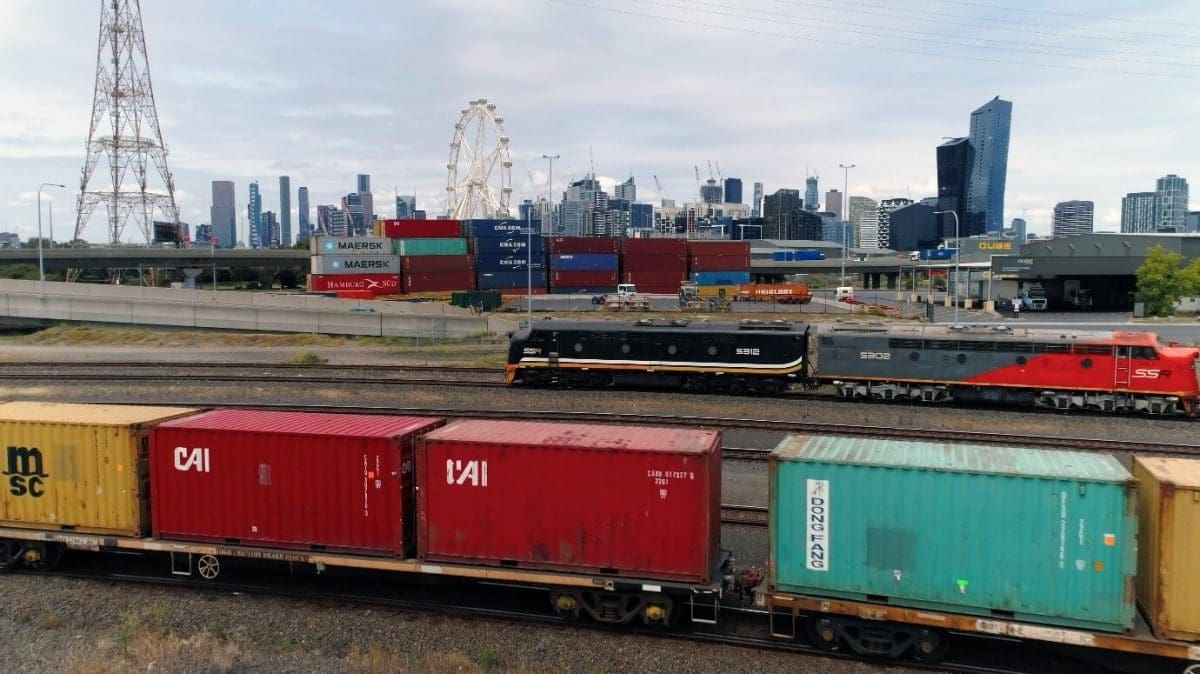
The proposed Somerton Intermodal Terminal will connect rail freight to the Port of Melbourne and to the national rail network. Photo: Port of Melbourne
SUPER fund-backed Intermodal Terminal Company (ITC) has announced plans to build and operate a $400-million intermodal terminal in Somerton in Melbourne’s northern suburbs.
The company claims the new project, when completed, will be “Australia’s largest intermodal terminal” as well as being the most logical and cost-effective Melbourne end-point for the Inland Rail project.
The 45ha Somerton Intermodal Terminal (SIT) is expected to be completed by 2025, and while it will cover a much smaller area than the National Intermodal Corporation’s 243ha Moorebank Intermodal Precinct in Sydney, its capacity is expected to be considerably higher.
Coleman Rail has been appointed as principal contractor to construct the Somerton terminal.
It will be located at the existing Austrak Business Park, which sits 12km from Melbourne Airport and 26km from the Port of Melbourne, and lies between the standard-gauge Sydney-Melbourne rail line and the Hume Highway.
The business park is currently home to Kraft/Linfox and Coles warehouses, a Boral concrete batching plant and Labelmakers Group offices and warehouse.
ITC was established in December 2022 and is owned by Aware Super, one of Australia’s leading industry super funds.
ITC founder and CEO Mishkel Maharaj said the SIT will be the first in a network of independently owned and operated terminals being planned across the country by the company.
“ITC is delighted to announce the Somerton Intermodal Terminal as the first independently constructed, maintained and operated terminal in our portfolio,” Mr Maharaj said in a statement.
“We welcome all participants in Australia’s supply chain to benefit from the strategic capacity this asset will introduce into the nation’s supply chain network.
“We’re especially pleased that once operational, the terminal will deliver additional benefits to the people of Melbourne every single day of its operation – through reduced carbon emissions and air pollution, reduced road congestion, and improved road safety.”
At capacity, each year SIT is expected to process over one million twenty-foot equivalent units (TEU) and take 500,000 truck trips off inner-Melbourne’s roads, equivalent to 454 million truck kilometres.
Victorian Government Minister for Ports Melissa Horne said the new terminal will bring benefits to a range of freight-reliant industries.
“The [SIT] is a city-shaping project – this private investment will supercharge job creation and support our commitment to move more freight by rail to port,” Ms Horne said.

Minister for Ports Melissa Horne.
“These direct rail connections will get trucks off roads, increase safety, reduce emissions and cut the cost of doing business for producers, farmers, exporters and operators.”
Possible Inland Rail link
The new SIT opens up a new option as the official “bookend” of the Inland Rail project.
In a media statement, the ITC said the terminal “will provide a cost-effective and efficient solution to maximise the utilisation of Inland Rail – which currently has no endpoint in Melbourne and no viable terminal solution – in time for its scheduled completion in 2027/8”.
The company also argues that the SIT will be the closest terminal in Melbourne able to double-stacked 1800m trains.
With a 2025 completion date, the SIT is expected to be the first of three possible Inland Rail endpoint intermodal hubs to be finished.
The Austrak site is built alongside a rail line that has access to the Port of Melbourne, all capital cities and major regional rail terminals via the ARTC National Standard Gauge Rail and the Victorian broad-gauge rail network.
Other terminal options
Currently, the Federal Government is backing a two-terminal strategy rather than a single-terminal solution, with sites under investigation at Beverage, also in Melbourne’s north, and Truganina, in the city’s western suburbs.
The terminal strategy is the subject of the Inland Rail Review, due to be completed soon, and could be changed depending on its outcome.
The SIT provides a third option and could be competition for the Beverage project, as the terminals would be located about 20km apart.
In the 2022-23 Budget, the Federal Government provided funding for both projects with $1.62B for the Beveridge terminal and $280M for road connection upgrades as well as $740M for the Truganina site – also known as the Western Interstate Freight Terminal (WIFT) – and $920M for the Outer Metropolitan Ring South Rail connection.
The Beveridge terminal will be owned by the Federal Government’s National Intermodal Corporation (NIC).
Currently, the Beveridge site could be operational in five years, while the WIFT would need seven years to construct, according to NIC CEO James Baulderstone.
Mr Baulderstone told Senate Estimates in November that there are “pros and cons” to both sites.
“Beveridge is the easier terminal to connect to Inland Rail because it sits right on the Inland Rail corridor.
“The Truganina site is more difficult; it needs a connection from either the south or the north, and that will take more time.”
Industry backs WIFT
The WIFT, which would be located about 35km south-west of Somerton, has been the preferred intermodal terminal site for industry members for several years.
It has support from advocacy groups Rail Freight Alliance and LeadWest, local governments and businesses including Linfox, Pacific National and SCT Logistics.
WIFT proponents argue it would be located close to about 50pc of the existing interstate freight rail customers and would provide easier access to rail freight connections for the significant existing warehousing and logistics companies.
They also say the Truganina site would lower overall costs for getting costs for getting regional Australian produce to market.
“We’re working to ensure the governments understand the value of intermodal freight terminal in Truganina for increasing productivity and delivering a better supply chain outcome benefiting both customers and the community,” Linfox CEO Mark Mazurek said in a statement.
“A freight terminal in the west will not only benefit industry, but it will drive better outcomes for the community, lowering the cost of delivering everyday items, delivering local jobs, easing traffic congestion, improving road safety and reducing greenhouse gas emission for the freight sector.”
The Port of Melbourne is Australia’s busiest container port, and handles large volumes of grain, pulse, fibre and oilseed exports from across Victoria and southern NSW.
Grain Central: Get our free news straight to your inbox – Click here

HAVE YOUR SAY